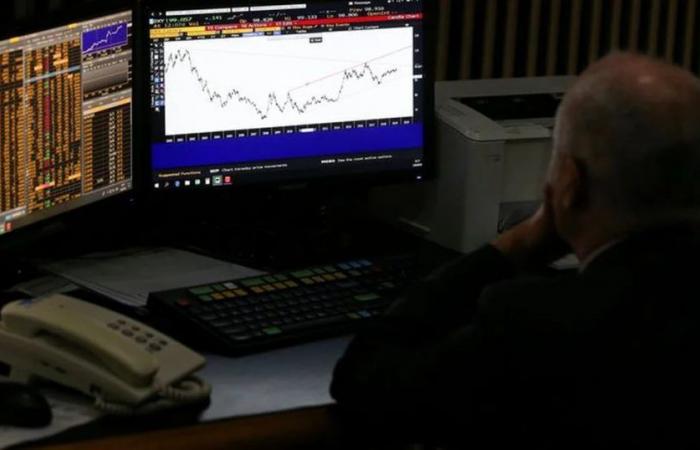
The declines in ADRs – certificates of ownership of Argentine shares listed on the New York Stock Exchange – raised doubts, despite the fact that the sharp falls, in the two rounds of holidays in Argentina, were without demand from Argentines, which are the main clients of that instrument that is quoted in pesos at the cash settlement exchange rate (CCL).
It should be noted that the most important drop in ADRs occurred on Thursday. On Friday the losses were moderate. Sovereign bonds, with little movement, fell 1.5% and the country risk rose 34 units (+2.6%) to 1,420 basis points. The decline in bonds had to do with a general fall in emerging countries.
In the midst of rumors that these falls heralded modifications to the exchange system due to the lack of settlements from exporters and the need to increase the Central Bank’s reserves, there was a post on “X” (former Twitter) by the Minister of Caputo marking three points:
- Follow the crawling at 2% monthly;
- The “blend” (80/20%) is not eliminated; and
- Negotiations for fresh money with the IMF did not begin.
Speculation about when the stocks will be eliminated did not calm down after the statement; There are even those who believe that this will happen on Monday, July 1. On the other hand, despite the fact that exports are not liquidated with the fluidity that the Government expected, a statement from the Argentine Agroindustrial Council praised the measure to simplify and deregulate “state barriers and restrictions that “prevent the fluid commercial activity of Argentine companies. abroad” by eliminating “the mandatory nature of foreign sales affidavits (DJVE) for productions from regional economies.”
The different reports from the consultants focused their attention on the stocks. According to the Center for Political and Economic Studies (Cepec) of Leo Anzalone “The lifting of the exchange rate cannot be achieved immediately. “It takes several months to meet the necessary conditions and ensure an orderly and stable transition.”
Current policies are on track, but require time to show tangible and sustainable results, the report stated. “Taking into account the current state of the necessary conditions and the outstanding challenges, it is reasonable to expect that the lifting of the stocks could be feasible from the end of 2024 or the beginning of 2025, provided that appropriate economic policies are maintained and reinforced. the expected progress is achieved in the key factors,” highlights the report, the final part of which recalls that in 2025 the Government will have to face high maturities of the external debt.
For its part, Bavsa warns that the interest rate of Treasury Bills has a greater risk of default than that of the remunerated liabilities of the Central Bank (BCRA), among other issues, because the Treasury does not issue the currency to cancel these liabilities. . “It goes without saying, furthermore, that the Treasury’s risk premium is strictly linked to its payment capacity. In this way, the reference rate of the economy begins to have a direct relationship with the fiscal situation of the Treasury and its future,” says a passage from the Bavsa report.
The size of the local short-term public debt market may not have sufficient scale to face major shocks to internal liquidity (Bavsa)
Furthermore, he adds: “the size of the local short-term public debt market may not have sufficient scale to face major shocks to internal liquidity. This is of utmost importance for a pressing problem for the Government such as long public securities that have put or put options. puts in the hands of financial entities that, according to estimates, reach $16.5 trillion. It could be thought of as a way out of this mess for the National Administration to exchange those long bonds with puts for short securities, such as Lecap, which would imply strong pressure on the market for these bonds.”
The consulting firm F2, from Andrés Reschini, alert while the weekly balance of the monetary authority for interventions in the exchange market “ended negative (-USD 74 million) for the first time since Milei took office.”
And he explains: Seasonality and a certain normalization in import payments do not promise positive results for the accumulation of reserves in the coming months.” For this reason, he continues, “it is becoming increasingly urgent to lift restrictions so that investments arrive and, furthermore, help support activity. The BCRA Passive Passes measured at the CCL would have already reached USD 15,000 million from USD 35,000 million in mid-May, a figure that Milei has repeated on several occasions as the amount to be obtained to lift the stocks. “It will now depend on how much is received and the risk that the Ministry of Economy is willing to take.”
For its part, the consulting firm 1816 recalls that Milei himself recently said that the puts that the banks have “are the last obstacle to lifting the stocks.” These early sale options to the BCRA of Treasury securities held by banks total $16.5 trillion and have recently been an emerging concern. The 1815 report states that half of the puts They expire in 2026 and 2027 and that is why they “are not an obvious impediment to lifting exchange controls.” Banks, remember, “have exercised puts for around $5.5 trillion so far this year, a figure that rises to $8.8 trillion if we do the calculation in constant June pesos. In other words, they have used puts to manage their portfolios in recent times. In any case, since April the exercise of puts has been considerably reduced compared to previous months.”
In this context, it is not ruled out that in the coming days the Minister of Economy, Luis Caputo, negotiate with the big banks to change the ways of trading puts; that they can only do it in emergency situations.
There are tensions in the external sector and the international context does not help. The Brazilian real went from 4.9 to 5.4 dollars and other Latin American currencies followed similar paths
For EconViews “regardless of whether there is an exchange rate delay or not, there are beginning to be tensions in the external sector and the international context does not help. In this regard, he points out evidence: the real in Brazil, which weeks ago was trading at 4.9 per dollar, today is above 5.4 reais per dollar. Other Latin American currencies followed similar paths. And he observes: “Beyond factors such as the elections in Mexico and the fear that Morena will make institutional reforms that displease the market, there is a common factor: the dollar is strengthening in the world. The Federal Reserve was slow to raise and now slow to lower rates and that leaves a strong dollar. That is to say that, without eating or drinking it, Argentina is left with a heavier weight than the Government was willing to assume.”
According to the consultancy headed by Miguel KiguelAnother problem, not independent of the strengthening of the dollar, is the weakening of the commodities agricultural. Soybeans are already below USD 420 per ton (on Friday they rose to USD 426 in Chicago). It is not a disaster, but the soybeans of 2008, when the crisis with the field occurred, would be equivalent to almost 900 dollars at today’s prices. Compared to the 2023 average, soybeans fell 17% in real terms. “It is not a minor loss. Wheat prices also fell sharply and corn somewhat less so. The terms of trade are not so bad in absolute terms, but they also reflect a more manageable drop of 3% year-on-year in the first quarter of the year,” adds Econviews.
The local level does not help calm things down. “Parallel dollars escaped when the BCRA lowered the interest rate a lot and there were doubts about the approval of the Bases Law, and they did not drop significantly once the law was approved. The exchange gap is above 40%, a worrying value. The second fact is that in June the BCRA almost did not buy dollars,” Econviews emphasizes. And he concludes: “this leads us to think that if the situation does not improve, more exchange rate flexibility will be needed, in line with what the IMF recommends in the IMF report. Staff Report. In fact, he observes, this seems to be Milei’s great challenge in political terms, since surveys continue to show favorable financial and fiscal data, but there is a demand for more activity and employment. “Our vision is that for this to go from a low flight to something more robust, we will have to take risks and lift the trap,” the consultant pointed out. It is an operation with more benefits than costs – he notes – since the fiscal fundamentals are solid (…) a more flexible exchange rate will bring the antidotes that are needed if the external issue becomes even more difficult and the headwind pity”.
Surveys continue to show favorable financial and fiscal data, but there is a demand for more activity and employment
Finally, Equilibra highlights an aspect that concerns the IMF staff and is not said openly: monetary-exchange policy is on an unsustainable trajectory. “The BCRA must maintain positive real interest rates, that is, higher than expected inflation. Even more importantly, the organization places the exchange rate in balance at values that at the end of May would be equivalent to $1,150, that is, 30% higher than the current one.” Later, the consulting firm headed by Diego Bossio and Martín Rapetti indicates that “at some point until 2025 the exchange rate should rise above prices and salaries.”
“The IMF suggests that this change could occur gradually as the Government lifts the restrictions. This would imply greater demand in the exchange market which, in a scheme of greater flexibility as requested by the IMF, the exchange rate would rise. We agree that the economy should follow that course if the stocks are made more flexible, but contrary to the Fund’s projection, we believe that an increase in the official dollar will generate more inflation and less growth,” observes Equilibra.
In light of such analyses, today’s round will focus on the market’s reaction to what happened on Thursday and Friday with local assets abroad. The tension will be placed on the prices of the dollar, sovereign bonds and stocks.





